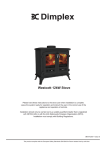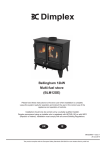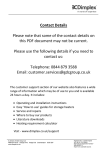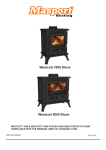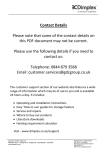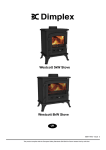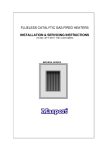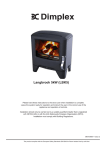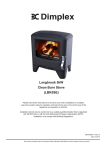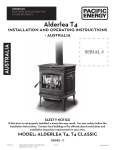Download Masport Westcott 3000 Operating instructions
Transcript
Westcott 3000 Stove WESTCOTT 3000 STOVE HAS BEEN TESTED TO SHOW COMPLIANCE WITH THE EMISSION LIMITS OF AS/NZS4013:1999 592007 2011-12-07 CONTENTS DIMENSIONS 1 DIAGRAMMES 2 SAFETY ADVISE 3 ASSEMBLY 3 INSTALLATION 3 OPERATING INSTRUCTIONS 4 SAFETY NOTES 5 GENERAL MAINTENANCE 5 TROUBLE SHOOTING 5 AFTER SALES SERVICE 6 SPARE PARTS WESTCOTT 3000 7 WARRANTY 8 WARRANTY REGISTRATION FORM 11 -1 1 ( # ,$IA * $ ' ! " + & % Table 1 - Dimensions A B C D E F G H J K L Westcott 3000 688 640 652 326 670 104 50 356 113 538 150 Note: All Dimensions in mm. Dimensions stated may be subject to a slight ± variation. Table 2 - Dimensions Flue Outlet Size Weight Westcott 3000 150 134 Note: All Dimensions in mm. Dimensions stated may be subject to a slight ± variation. 2 3 ! ! # X " 8 - 2- 4 5 X 6 " # $ ! ! 7 8 - 3- Wescott 3000 IMPORTANT: THESE INSTRUCTIONS SHOULD BE READ CAREFULLY AND RETAINED FOR FUTURE REFERENCE Important Safety Advice Assembly of the stove Please read these instructions carefully before installing or using this appliance. Failure to do so may result in damage to persons and property. To make the product easier for handling on installation, remove the baffle plate, side bricks, back brick and door. Place these in a secure place to avoid damage. These must be refitted after installation. Installation of this appliance must be carried out by a suitably qualified competent person in accordance with all Building Regulations, including those referring to Local Authority Bye-Laws, National Standards and Codes of Practice. The legs and other fixings are packed in the ashpan for safe keeping in transport. Fix the legs to the underside of the product using the bolts provided (Fig 2). Do not install this appliance on a shared flue. This appliance operates at very high temperatures and retains its heat for a period after use. Do not touch any surfaces while in use. All persons including children and the infirm should be warned of this and not allowed to touch any surfaces while in use. Please use a suitable fireguard to prevent contact when in use. Do not place any photographs, paintings, TV’s or other combustible items near the appliance as exposure to hot surfaces will cause damage. Maintain safe distances from combustibles in all cases in accordance with these instructions – please refer to installation. The operator must use the tools provided. The mitten provided is a tool. Ensure that there is adequate ventilation in the room in accordance with building standards. Do not obstruct any of the air inlets or outlets on the appliance. A flue damper should not be fitted. This appliance is for domestic heating use only in accordance with these operating instructions. Do not make any unauthorised changes to the appliance. Only use recommended fuels. Do not burn petroleum coke fuels, household waste or plastic in this appliance. Use hardwood only with a moisture content of less than 25%. Burning soft or wet fuels such as unseasoned timber, painted or treated timber will only result in a build up of tar in the stove and the flue pipe and will cause staining of the glass. Do not use flammable liquids to ignite the fire. Avoid the use of aerosols in the vicinity of the stove when it is in operation. Clean your flue pipe at once a year (Check your House Fire Insurance) to ensure there are no blockages. Do not allow a build up of ash to occur in the ash pan as this will cause the grate to burn out prematurely. Regular maintenance should be carried out by a Competent Engineer. The stove is supplied ready for top flue connection. For Rear flue connection (Fig 3) remove the heat shield cover (A) and collar (B). Rotate the expanding range (C) to face in desired direction for rear flue connection and refit the collar. Tighten all fixing screws and seal with fire cement to ensure it is air tight. The primary air sealing plate is located on the front of the grate. To locate in position, slacken the screws beneath the grate and pull forward, then close the door fully, open again and tighten the screws (Fig 4). Installation Instructions General These instructions give a guide for the installation of the stove but in no way absolves the installer from responsibilities to conform to all relevant standards relating to the installation of solid fuel appliances. In the interests of your safety, most building regulatory Authorities in Australia and New Zealand require any wood fire installation to comply with Installation Standard AS/NZS 2918. They may also have local requirements in addition to those in the Standard. Check with your local Building Authority before commencing installation to find if you will require a Permit and whether there are extra requirements. All our Wood fires have been tested to ensure that they will meet the appropriate safety Standard requirements if the instructions in this book are followed. As the safety and emissions performance can be affected by altering the appliance, no modifications are allowed without written permission from the manufacturer. We recommend that a qualified specialist installer should be used. Please note that to the best of our abilities these instructions are correct at time of printing, however we cannot be held responsible for any differences in legislation which may occur in the future. An extractor fan must not be used in the same room as this appliance. NOTE: WHILE ALL MODELS HAVE BEEN TESTED TO SHOW COMPLIANCE WITH THE EMISSION LIMITS OF AS/ NZS.4013:1999, ONLY SOME MODELS MAY BE INSTALLED IN DISTRICTS HAVING LOWER ALLOWABLE EMISSION LIMITS. PLEASE CHECK WITH YOUR BOROUGH OR SHIRE COUNCIL BEFORE PURCHASING A HEATER OR INSTALLING A WATER BOOSTER. WARNING: APPLIANCES INSTALLED IN ACCORDANCE WITH THIS STANDARD SHALL COMPLY WITH THE REQUIREMENTS OF AS/NZS 4013 WHERE REQUIRED BY THE REGULATORY AUTHORITY, I.E. THE APPLIANCE SHALL BE IDENTIFIABLE BY A COMPLIANCE PLATE WITH THE MARKING ‘TESTED TO AS/NZS 4013’. ANY MODIFICATION OF THE APPLIANCE THAT HAS NOT BEEN APPROVED IN WRITNG BY THE TESTING AUTHORITY IS CONSIDERED TO BE IN BREACH OF THE APPROVAL GRANTED FOR COMPLIANCE WITH AS/ NZS 4013. -4- Floor Protection & Installation Clearances Please refer to the specific ‘Installation Specifications’ for the stove concerned supplied with the stove. Flue Connection You MUST use a flue system, which complies with the current installation Standard AS/NZS 2918. Full instructions are supplied with the flue kit, and these MUST be followed closely, including the minimum flue exit height from the top of the floor protector and the minimum exit height above the roofline or roof ridge as detailed in the instructions. Other Flue Systems Flues and flue heat shields other than those listed on the Installation Specification Sheets may be used, but if they have not been tested with these heaters, their installation clearances will be those specified in AS/NZS 2918:2001 for untested flue installations. Unless otherwise specified, all heat sensitive wall material must be kept at least 600mm away from any flue, which is not fitted with a flue heat shield. Always seal the flue to the flue socket of the firebox using firebox cement or fiberglass rope. Connect the flue pipe to the stove making sure that it fits snugly into the base of the flue collar (Fig.5). Seal the collar and flue connection with fire cement or with other suitable high temperature sealant. Add flue sections as required; note that all flue sockets must face upwards. Avoid using bends greater than 45° to the vertical. All flue pipes should be as close to vertical where possible. For rear flue connection the length of the horizontal run of the flue pipe should not exceed 150mm. This product should not be installed on a shared flue. Commissioning Upon completion of installation, the stove and flue system should be tested by a suitably qualified person to make sure it is safe for normal use. A smoke draw test should be completed to check for soundness of joints and seals and also that all smoke and fumes are taken from the appliance up the chimney and emitted safely. First warm the flue with a blowlamp or similar for about 10 minutes. Place a lit smoke pellet on the centre of the grate with the air controls open. Close the door – the smoke should be drawn up the flue and be seen to exit from the flue terminal. Complete the test with all windows and doors shut in the room where the appliance is fitted. If a ceiling fan is present it must be operated on max for the duration of the test. If there are any extraction fans in adjacent rooms these too must be operated on maximum setting during the test with the interconnecting doors open. If any spillage occurs, recheck the suitability of the flue system making sure there is adequate air supply to the room (as per Building Regulations). Light the appliance and slowly increase the temperature to operating levels. Open the main fire door when the appliance reaches normal operating condition and carry out a spillage test using a smoke match or pellet around the door opening. If any spillage occurs, open all windows, allow the fire to go out and recheck the flue system and ventilation. Operating Instructions Warning: The door and operating handles become hot when the stove is in use. For your safety use the glove provided. Initial Firing of Stove We recommend that you have two to three small fires before you operate your stove to maximum heat output. This is to allow the paint to cure and the castings to relax and consolidate location. We recommend this ‘running in’ procedure after long idle periods to preserve the life of the stove. During this you may notice an unpleasant smell. It is not toxic but for your own sake we would suggest that during this period you leave all doors and windows open. Air Controls Primary air is controlled via the sliding vents (A - Fig 6) in the bottom of the door; this provides a conventional air draught to the bed of the fire. (+) indicates more air, (-) indicates less air, (+) and (-) are marked on the primary and secondary air controls. Secondary air is controlled via the sliding vent (B - Fig 6) above the door. It is this ‘Airwash’ that keeps a clean and uninterrupted view of the fire, also aiding in good secondary combustion of fuel and reducing emissions into the chimney and environment. The Westcott 3000 is fitted with a tertiary (third) air inlet system. Air is bled into the stove from the rear panel via an air duct over the rear brick. Its function is to ignite unburned gasses and assist clean burning. It is advisable to clear the holes in the duct occasionally when the stove is being serviced or after long periods of burning (dirty) fuel, i.e. bitumas coal. For safety this should only be done when the stove is cold. The tertiary air supply is permanently open and only allows a small fixed amound of air into the stove. However if you suffer from poor flue draft or regularly use smokeless fuel it may beneficial to close off the tertiary air supply. To close tertiary air, wait until stove is cool, remove the heat shield cover (A - Fig 3), fit the screw plugs supplied into 2 holes on rear of stove (X - Fig 3) and replace heat shield cover. Lighting the Stove Place fire lighters or paper and kindling on the grate. Light the fire at base leaving all air controls open. Allow the fuel to reach a steady glow and build the fire up gradually. Once you have a good fire established across the grate bed, further fuel can be added as required. Running the Stove When your fuel is well alight you can start to restrict the primary air intake. If you are only burning wood the primary air control can be fully closed. If you are burning solid fuel you will require more primary air. Your stove is burning with maximum efficiency when a bright fire is achieved using minimum air inlet. The stove can be banked up for long periods. When burning solid fuel empty the ash pan. Open air controls and let the fire burn brightly for a short period. Refuel and close air controls; the exact setting required will depend on the fuel used and the chimney draw so some practice may be necessary. To revive the fire, open air controls until the fire is burning brightly, de-ash if necessary and refuel. Set air controls as required. The stove is not suitable for overnight burning. - 5 `- Notes on Wood Burning Wood burns best on a bed of ash and it is therefore only necessary to remove surplus ash from the grate occasionally. Burn only dry, well seasoned wood, which should have been cut, split and stacked for 12 months with free air movement around all sides of the stack to enable it to dry out. Burning wet or unseasoned wood will create tar deposits in the stove and chimney and will not produce a satisfactory heat output. When loading wood, make sure that the end grain of the wood in the stove is pointing away from the glass otherwise the moisture and gases coming from the end grain of the wood will dirty the glass. Warning - Fume Emissions Properly installed and operated, this appliance will not emit fumes. Occasional fumes from de-ashing and refuelling may occur. Persistent fume emission must not be tolerated. If fume emission does persist, then the following immediate action must be taken: 1. Open doors and windows to ventilate the room. 2. Let the fire out, or eject and safely dispose of fuel from the appliance. 3. When the stove has cooled, check for chimney flue blockage and clean if required. Do not attempt to relight the fire until the cause has been identified. If necessary seek professional advice. Table 5 - Maximum log lengths Westcott 3000 500mm Petroleum coke fuels or household waste should not be burned on this appliance. De-Ashing To de-ash the grate insert the notch on the riddle hand tool into the peg on the side of the stove (D - Fig 6), then draw the tool forwards and backwards with a slow positive action (Fig 7). The ash pan should be emptied each time after operating the stove so not to let build up of ash occur. Where possible, it is best to wait until the stove and ash has cooled before removing the ash pan. To remove, open the stove door by lifting the handle upward (C - Fig 6 then using the riddle handle lift the ash pan out of the fire (Fig 8). For efficient burning of your appliance, make sure the grate is clear of burnt debris; e.g. nails, etc. Shut down Periods If shutting down the stove for long periods (e.g. for summer months) make sure that all ash is removed from the stove and that the chimney flue ways and baffle plate are brushed clean. When the stove is cold a vacuum cleaner may be used to remove any residual ash or soot. Close the door and leave all air inlets open fully. This action will ensure air circulation through the appliance and will help to avoid corrosion and condensation within the appliance during this shut down period. Safety Notes for Your Guidance FIRES CAN BE DANGEROUS. Always use a fire guard in the presence of children, the elderly or the infirm. Inform all persons the dangers of high temperatures during operation of the appliance including the stove pipe. Use operating tools provided. DO NOT OVER FIRE. It is possible to fire the stove beyond its design capacity. This could damage the stove, so watch for signs of over firing. If any part of the stove starts to glow red, the stove is in an over fire situation and the controls should be adjusted accordingly to reduce air intake. Never leave the stove unattended for long periods without adjusting the controls to a safe setting. Careful air supply control should be exercised at all times. General Maintenance Baffle Plate This should be removed at least once a month to prevent any build up of soot or ash, which could lead to blocked flue ways and dangerous fume emission. If the baffle plate is removed the flueway can be swept through the appliance. Stove Body The stove is finished with a heat resistant paint and this can be cleaned with a soft brush. Do not clean while the stove is hot, wait until it has cooled down. The finish can be renovated with a suitable brand of paint. Glass Panels Clean the glass panels when cool with a proprietary glass cleaner. Highly abrasive substances should be avoided as these can scratch the glass and make subsequent cleaning more difficult. Wet logs on heated glass, a badly aimed poker or heavy slamming of the doors could crack the glass panels. The glass will not fracture from heat. Flue Pipes Check your flue pipe each year before starting to use your stove for the winter. Birds may have nested in the flue cowl. The flue pipe must be swept at least once a year by a Qualified Chimney Sweep. To avoid a build up of soot on the baffle plate (the plate inside the stove above the grate) it must be removed and cleaned periodically. This plate locates the back and side firebricks so note its position before removal. To remove, lift plate and remove one side brick; this will allow the plate to drop and aid removal. To replace, position baffle plate on back and side plate, lift plate and replace remaining brick, making sure it has located in position. This must be done when the stove is cold. Troubleshooting 1. Poor heat output a. Stove too small for room: Seek advice from a Qualified Heating Engineer as to (kW) output required for the room size. As a guideline the volume of the room in cubic feet divided by 500; e.g. room 15’x15’x8’ would require 3.6kW approx. b. Chimney and/or flue pipe restricted, room ventilation restricted: On installation these should have been checked but regular maintenance is necessary as conditions can change; e.g. soot build up, birds nesting, masonry fall, dust build up or furniture blocking vents. c. Poor quality fuel: Only burn dry seasoned timber, soft woods have a lower heat output than hard woods per hour. - 6- 2. Dirty Glass Panel a. Generally caused by poor fuel quality, see (1c) b. Use secondary air slide (Airwash) for glass panel c. Fire burning too low, open air vents on stove to create hot fire; this may ‘burn’ glass clean. d. If glass requires cleaning use glass cleaner recommended by your supplier; only use glass cleaner on cold glass. DO NOT USE any abrasives or scrapers as these will scratch glass and increase future tar build up making it harder to clean. 3. Unburnt Fuel in Firebox Insufficient air reaching fuel. Open primary air slide, this will supply combustion air to burn fuel fully (unless it has reached a ‘point of no return’) Check if the ash pan is full and empty if required. De-ash with the riddler to make sure the grate is not blocked and check for jammed clinker or nails when the fire is out and the stove has cooled. 4. Smoke and Fumes Entering Room These are very dangerous and must NOT be tolerated. Open window and allow fire to burn out. Seek expert advice immediately. DO NOT USE stove until the problem is solved. 5. Fire inside the Flue Pipe Identified by loud roaring sounds, dense smoke and sparks emitting from top of flue. Shut down the air supply by closing air vents, close stove door fully and call fire brigade immediately. Regular flue cleaning will prevent flue fires. Seek advice from a Qualified Chimney Sweep. Flues must be checked annually and more often when bitumas coal and poor quality smokey fuels are used. After Sales Service Please see warranty details at rear of this manual. Should you require after sales service or should you need to purchase any spares, please contact the retailer from whom the appliance was purchased. Please do not return a faulty product to us in the first instance as this may result in loss or damage and delay in providing you with a satisfactory service. Please retain your receipt as proof of purchase. - 7- WESTCOTT 3000 WESTCOTT 3000 STOVE - SPARE PARTS Item Description Part No 1 Door Accessory Pack (x1 LH, x1 RH) MF09001 2 Grate Accessory Pack (incl Grate Outer, x10 Grate bars) MF09002 3 Adjustable Grate Plate MF09003 4 Baffle Plate Accessory Pack MF09004 5 Air Wash Deflector Plate MF09005 6 Primary Air Slide MF09006 7 Grate/Ashpan Operating Tool MF09007 8 Front Bar (Log bar) MF09008 9 Legs Accessory Pack (x2 off) MF09009 10 Door Handle Accessory Pack (x1 steel, x1 black finish) MF09010 11 Hinge Pins (x2 off) MF09035 12 Air slide knob Accessory Pack (x1 steel, x1 black finish) MF09011 13 Ash Pan MF09012 14 Door Glass Accessory Pack (includes clips) MF09013 15 Heat Bricks Accessory Pack (x2 side bricks, x1 rear brick) MF09014 16 Mitten MF09036 - 8- MASPORT PRODUCT WARRANTY WOOD & MULTI-FUEL FIRES (Radiant & Convection) This document sets out the express warranties that apply in respect of Masport products purchased in Australia and New Zealand. For Masport products purchased in Australia, the express warranties in this document are provided by Glen Dimplex Australia Pty Limited ABN 69 118 275 460 of Unit 1, 21 Lionel Road, Mount Waverley, Victoria 3149 (Phone number 1300 556 816) and for Masport products purchased in New Zealand, the express warranties in this document are provided by Glen Dimplex Australasia Ltd, New Zealand registration number 1506305, of 38 Harris Road, East Tamaki, Auckland, New Zealand (Phone number 09 2748265) (we, us our). The express warranties in this document apply to the particular Masport product which this warranty card has been included in the packaging for or otherwise supplied with (the Masport product). 1 Masport express warranty Subject to the exclusions in section 2, we warrant under this express warranty that the below parts of the Masport product will be free from defects of materials or workmanship for the periods specified below (with each of the below periods commencing on the date the Masport product was purchased by you as a brand new product from a retailer located in Australia or New Zealand): TYPE OF PART WOOD FIRE FIRE BOX, CAST IRON WOOD FIRE FIRE BOX, STEEL MULTI FUEL FIRE BOX, CAST IRON MULTI FUEL FIRE BOX, STEEL DOOR GLASS & SEAL FIREBRICKS / BOARDS & RETAINERS SECONDARY AIR TUBES BAFFLE COMPONENTS WATER BOOSTER GLEN DIMPLEX FLUE SYSTEMS FANS & ELECTRICAL COMPONENTS WARRANTY (In Years) PARTS LABOUR 10 5 10 5 5 2.5 5 2.5 1 1 1 1 1 1 1 1 1 1 1 1 1 1 * Where a Masport product is covered by a parts and labour warranty, the warranty covers both the repair of the defective part or the provision of a spare part to replace the defective part and the installation of that part. ** Where a Masport product is covered by a parts only warranty, the warranty covers only the repair of the defective part or the provision of a spare part to replace the defective part and does not include the removal of the defective part or the installation of the repaired or replaced part. This express warranty is personal to the first person who acquires the Masport product from the relevant retailer and claims under this warranty cannot be made by anyone other than this person. The benefits conferred by this express warranty are in addition to the Consumer Guarantees referred to in section 3 and any other statutory rights you may have under the Australian Consumer Law, the New Zealand Consumer Guarantees Act and/or other applicable laws. - 9- 2 Warranty exclusions This express warranty does not apply where: (a) The Masport product has been installed, used or operated otherwise than in accordance with the product manual or other similar documentation provided to you with the Masport product; (b) The Masport product requires repairs due to damage resulting from accident, misuse, incorrect installation, cleaning or maintenance, unauthorised modification, tampering or unauthorised repairs by any persons, use of defective or incompatible accessories or exposure to abnormally corrosive conditions; (c) The defective part relates to a consumable part of the Masport product which require routine replacement, or the pot belly stove grates; (d) You are unable to provide us with reasonable proof of purchase for the Masport product; (e) The breakdown occurs after the expiry of the express warranty period set out in section 1; or (f) The Masport product was not purchased in Australia or New Zealand as a brand new product. 3 Consumer Guarantees Our goods come with guarantees that cannot be excluded under the Australian Consumer Law. You are entitled to a replacement or refund for a major failure and for compensation for any other reasonably foreseeable loss or damage. You are also entitled to have the goods repaired or replaced if the goods fail to be of acceptable quality and the failure does not amount to a major failure. If you acquired the goods in New Zealand, similar provisions of the Consumer Guarantees Act 1993 may apply, but may be excluded if you acquired the goods for the purpose of a business. 4 How to make a claim You may make a claim under this warranty by visiting our website (www.masportheating.com.au in Australia, www.masportheating.co.nz in New Zealand), contacting our customer care line (1300 556 816 in Australia, 09 2748265 in New Zealand) or visiting a Glen Dimplex service centre. To make a valid claim under this warranty, you must: (a) Lodge the claim with us as soon as possible and no later than 14 days after you first become aware of the breakdown; (b) Provide us with the Masport product serial number; (c) Provide us with reasonable proof of purchase for the Masport product; and (d) If required by us, provide us (or any person nominated by us) with access to the premises at which the Masport product is located at times nominated by us (so that we can inspect the Masport product). - 10- 5 Warranty claims If you make a valid claim under a parts and labour warranty and none of the exclusions set out in section 2 apply, we will, at our election, either: (a) Repair the relevant part of the Masport product; or (b) Replace the relevant part of the Masport product with a product of identical specification (or where the product is superseded or no longer in stock, with a product of as close a specification as possible). We will also arrange for the relevant repaired or replacement part to be installed at no charge to you. If you make a valid claim under a parts only warranty and none of the exclusions set out in section 2 apply, we will, at our election, repair or replace the relevant part. You acknowledge that installation is not covered under a parts only warranty, however, we may, for a fee, install the repaired or replacement part for you. We will, on request, provide you with a quote for the installation of the repaired or replacement part. Goods presented for repair may be replaced by refurbished goods of the same type rather than being repaired. Refurbished parts may be used to repair the goods. Masport products are designed and supplied for normal domestic use. We will not be liable to you under this warranty for business loss or damage of any kind whatsoever. 6 Costs of warranty claim Where you make a claim under this warranty, a Glen Dimplex authorised repairer may need to attend your premises to inspect the Masport product. For Masport products located in Australia, we may charge you a service call fee if a repairer will be required to travel more than 30 kilometers from the nearest Glen Dimplex service centre to your location. You may obtain details on the location of our service centres and our service call fees by visiting our website (www. masportheating.com.au in Australia, www.masportheating.co.nz in New Zealand) or calling our customer care line (1300 556 816 in Australia, 09 2748265 in New Zealand). Distributed in Australia by: GLEN DIMPLEX AUSTALIA PTY LTD Unit 1/21 Lionel Road, Mount Waverely, Victoria, 3149, Australia Phone: 1 300 556 816 Fax : 1 800 058 900 Email : [email protected] Web : www.glendimplex.com.au - 11- GLEN DIMPLEX WARRANTY REGISTRATION WOOD & MULTI-FUEL FIRES (RADIANT & CONVECTION) Thank you for purchasing a Masport Fire. We ask you to complete the following information and return to the Glen Dimplex Warranty Registration Department on following address: New Zealand: P O Box 58473, Botany, Manukau 2163, Auckland Australia: Unit 1/21, Lionel Road, Mount Waverley, Victoria 3149 Mr / Mrs / Miss / Ms Name: _______________________________________________ Cut Here Address: _______________________________________________________________ _____________________________________ Post Code: Telephone: _________________________ Email ______________________________________________________________ Model: _________________________ Serial Number: ______________________ Retailer: _________________________ Purchase Date: ______________________ Price: _________________________ Installed By: _________________________ Fax: _______________________________ Date Installed: _______________________ We at Glen Dimplex strive to provide you with quality products and have continuous product development program. To help achieve our objectives to our mutual benefit we would welcome your feedback on the following questionnaire. Question Please tick appropriate remark 1. General presentation of Product □ Excellent □ Good □ Ok □ Needs to Improve 2. Styling and Looks □ Excellent □ Good □ Ok □ Needs to Improve 3. Packaging □ Excellent □ Good □ Ok □ Needs to Improve 4. Is documentation easy to follow? □ Excellent □ Good □ Ok □ Needs to Improve 5. Fixtures & Fittings (Loose parts) □ In order □ Items missing 6. Do you currently own Masport or Dimplex product? □ Yes □ Needs to Improve □ No Which? ______________ 7. Why did you decide on Masport? (tick one or more options)□ Knew this brand □ Suggested by Friend □ Dealer Recommended □ Better Price□ Performance □ Features 8. Other Comments: _________________________________________________________________ Privacy Act Notice: the owner named on the Warranty Registration consents and agrees that Glen Dimplex may retain and use the information in this warranty card, including details about the owner for marketing and development purposes. The owner also agrees that Glen Dimplex may also share purposes with [intended recipients of such information]. In accordance with the New Zealand Privacy Act 1993 and the Australian Privacy Act 1988, the owner shall have the right to request the correction of, as well as inspect, all personal information held by Glen Dimplex on that owner. Cut Here Please cut and mail this completed form within 30 days of installation to your Glen Dimplex Warranty Registration Department at the above address















